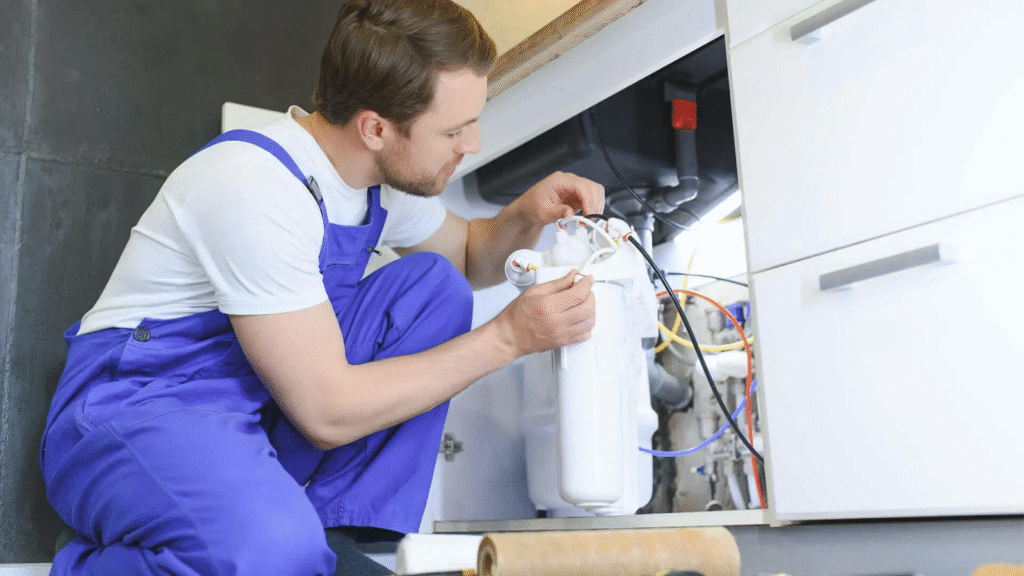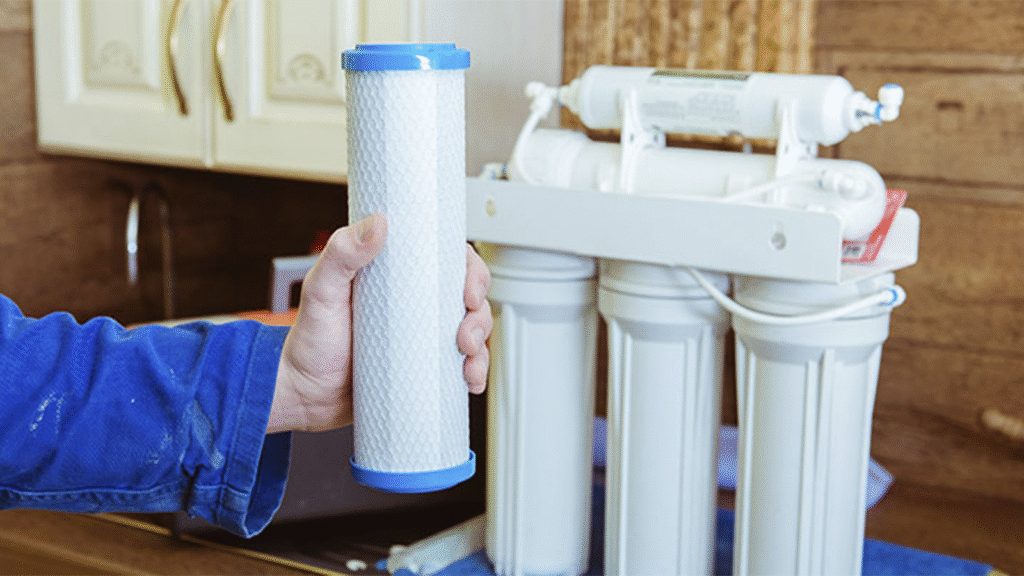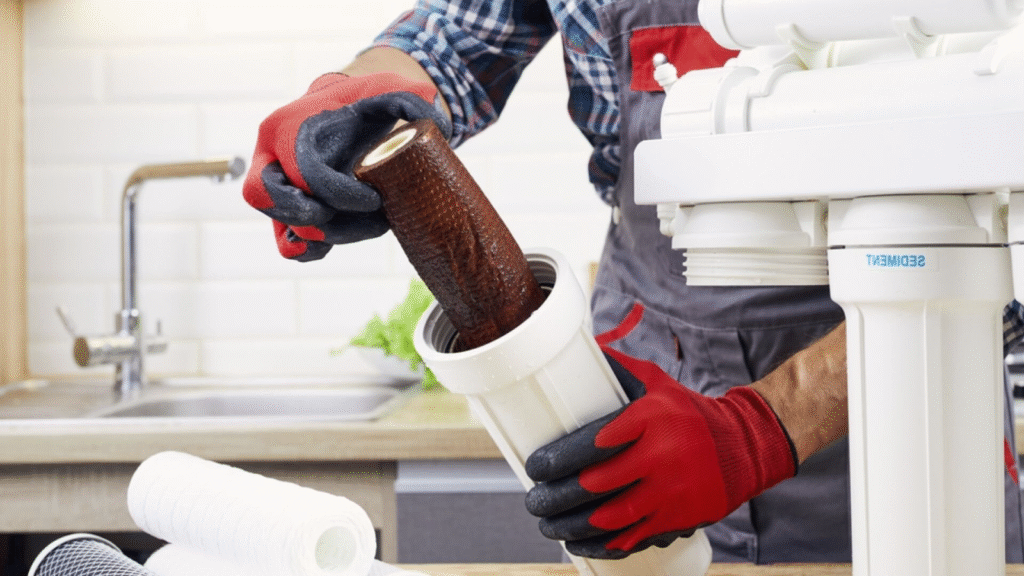Edmonton’s hard water is a daily battle that affects your appliances, plumbing, and even your skin. If you have invested in a water softener, you are already on the right path. But your system won’t do its job unless you do yours…by properly refilling the salt and cleaning the brine tank.
Whether you’re a new homeowner in the city or someone finally ready to tackle softener upkeep, this guide has you covered. From why salt matters to when and how to clean the brine tank, we’ll walk you through every step. And yes, we’re talking specifically about Edmonton’s water conditions, so this advice is for you.
Table of Contents
ToggleWhy Refilling Salt and Cleaning the Brine Tank Is Essential
Edmonton’s water is classified as moderately hard to very hard, averaging 120–180 mg/L of calcium carbonate. That means your water softener is working overtime to remove minerals like calcium and magnesium.
Over time:
- Salt levels deplete, reducing the softener’s efficiency.
- Brine tanks accumulate sludge, undissolved salt, and iron residue.
- You may notice scale on faucets, soap scum, and scratchy laundry, even though you have a water softener.
Consequences of Neglect
- Shortened lifespan of your water softener system
- Costly repairs or total breakdown
- Scale buildup in pipes and heaters
- Poor water taste or smell
- Potential void of the manufacturer’s warranty
Regular refills and cleaning can extend your unit’s life by 5+ years and keep water quality at optimal levels.
What Exactly Does the Brine Tank do
The brine tank stores salt, which is dissolved to create a brine solution used during the regeneration cycle. This solution flushes hard minerals from the resin beads.
Types of Salt Commonly Used
| Type | Pros | Cons |
| Evaporated Salt Pellets | Highest purity, minimal residue | Expensive |
| Solar Salt | Affordable, moderate purity | May cause more buildup |
| Rock Salt | Cheapest | Leaves the most sediment |
For Edmonton’s high mineral content, evaporated pellets or solar salt are preferred.
How Often Should You Refill Salt?
There’s no one-size-fits-all answer. But for Edmonton homes, the sweet spot is:
- Every 4–6 weeks for a family of 4
- Check every 3–4 weeks in winter when water use increases
- Keep salt above the water level, but not more than 2/3 full
Pro Tip: Set a calendar reminder or use a softener with a salt sensor alert.
How to Refill Salt Safely
Step-by-Step Instructions
- Open the Brine Tank Lid
Wipe away any moisture or salt crusting.
- Check Salt Level
If it’s below ¼ full or you can see standing water…it’s time.
- Break Up Salt Bridges
Use a broom handle to gently poke. A salt bridge is a hard crust that forms and gives a false reading.
- Add Salt
Pour salt evenly, not all at once. Avoid overfilling.
- Close Lid and Rinse Exterior
What to Avoid
- Using table salt or dishwasher salt
- Pouring salt over the residue or dirty salt
- Letting salt fall below the water line frequently

When and How to Clean the Brine Tank
How Often Should You Clean It?
In Edmonton’s mineral-heavy water, clean your brine tank:
- Once every 6–12 months
- More often, if you use rock salt or see brown sludge
Signs You Need a Clean
- Water feels hard despite a full salt tank
- Foul or rotten egg smell
- The tank has dirty water or floating debris
- Salt bridges form too often
How to Clean the Brine Tank (Step-by-Step)
Tools Needed
- Bucket
- Wet/dry vacuum or turkey baster
- Dish soap
- Long-handled scrub brush
- Warm water
- ½ cup of unscented bleach (optional for disinfection)
Instructions
- Turn Off the Water Supply and Unplug the Softener
- Remove Salt & Water
- Scoop salt into a bucket
- Use a wet vac to remove standing water
- Scrub the Tank
- Mix warm water and dish soap
- Scrub inside thoroughly
- Optional: Sanitize with Bleach
- Mix 1 gallon water + ½ cup bleach
- Let sit for 15 minutes, then rinse thoroughly
- Rinse and Dry
- Let air-dry before adding new salt
- Reconnect the System and Plug It Back In
Localized Tips for Edmonton Homes
Dealing With Iron in Water
Edmonton water sometimes contains iron, which leads to reddish sludge. Use iron-out salt or resin cleaners every few months.
Winterizing Your Brine Tank
- Install in a temperature-controlled space
- Never let salt or water freeze
- Use a tank jacket or insulating cover if your tank is in a garage or basement
Avoiding Salt Mushing
This happens when dissolved salt recrystallizes into a thick layer of slush. To avoid this:
- Don’t mix salt types
- Keep the ankle clean
- Stir salt occasionally with a long spoon
FAQs
Q1: What salt should I use in Edmonton?
Use evaporated salt pellets or solar salt for optimal results.
Q2: How do I know if my water softener is using salt?
Check salt levels weekly and monitor for signs of hard water returning. Also, listen for the regeneration cycle.
Q3: What happens if I forget to refill the salt?
Your softener stops working, and hard water flows into your home. Scale buildup can occur in just days.
Q4: Can I clean the tank without unplugging the unit?
It’s not recommended. Unplugging ensures safety and prevents accidental cycling.
Professional Help vs. DIY in Edmonton
| Task | DIY | Call a Pro |
| Refill Salt | Easy for all users | Rarely needed |
| Brine Tank Cleaning | Annual task for most | If iron/sludge buildup is excessive |
| System Inspection | May miss critical faults | Recommended every 2–3 years |
If you’re unsure about tackling cleaning yourself, consider booking a free consultation with Water Softener Edmonton for safe, expert advice and inspections.
How Water Softener Edmonton Can Help
At Water Softener Edmonton, we know that routine maintenance makes all the difference. Our team offers:
✔ Free Water Quality Testing
✔ Scheduled Maintenance Reminders
✔ Affordable Salt Delivery & Tank Cleaning Services
✔ Winterized Systems and Insulation Upgrade
✔ Customized Residential Solutions Across Edmonton
You don’t have to do it all alone. We’re just a phone call away.
Don’t Let Maintenance Be an Afterthought
Your water softener protects your home from Edmonton’s hard water, but it needs protection too. Learning how to refill salt and clean the brine tank is an investment in your home’s plumbing, your appliances, and your family’s comfort.
Put it off, and you risk expensive repairs. Stay consistent, and your system will serve you for years.
Ready to give your softener the care it deserves?



